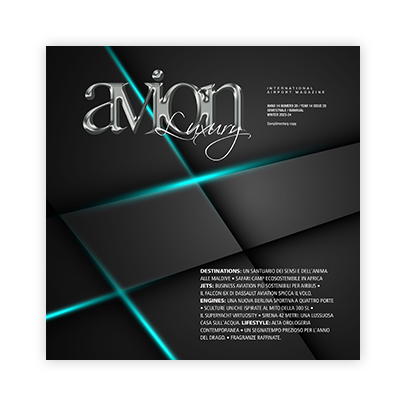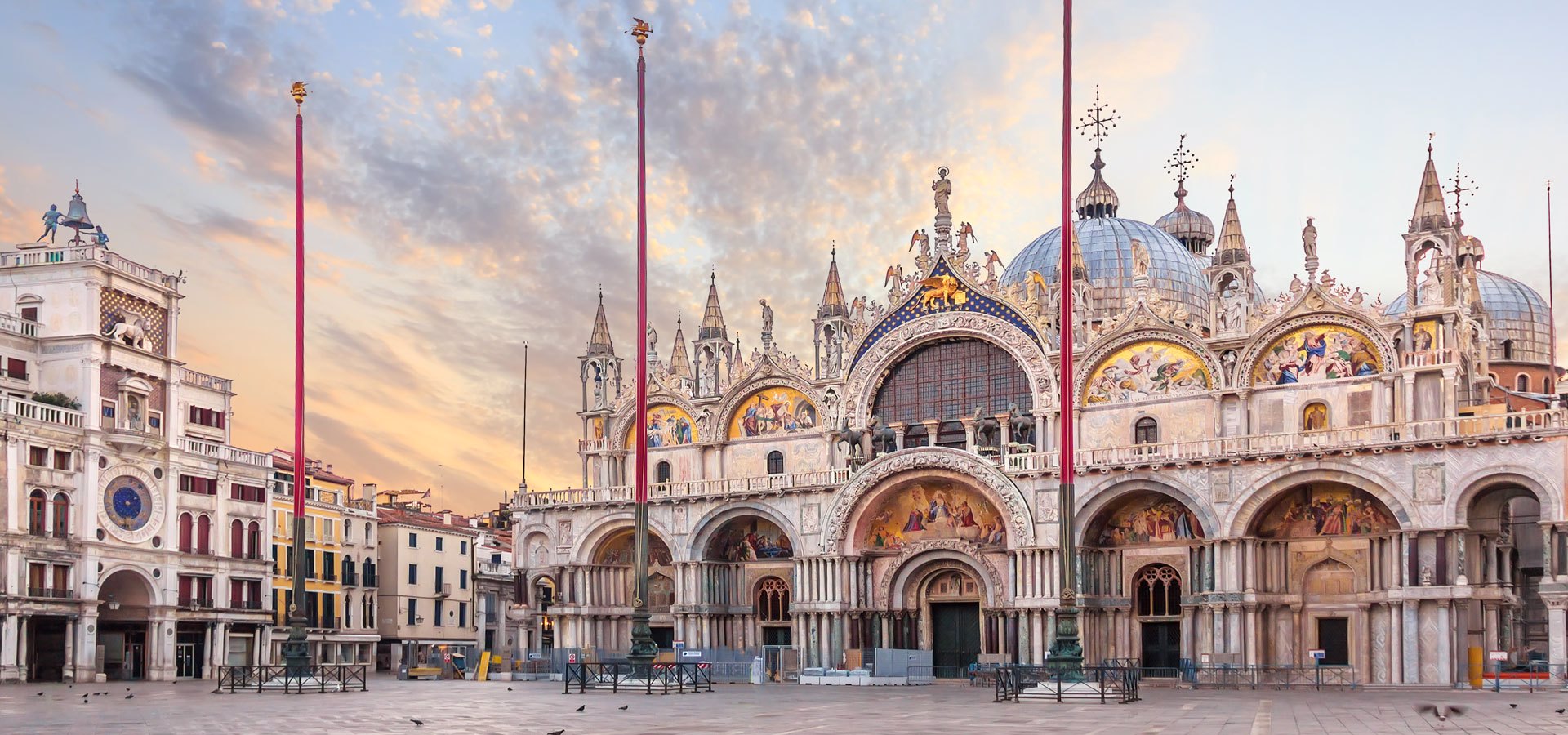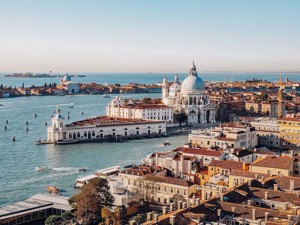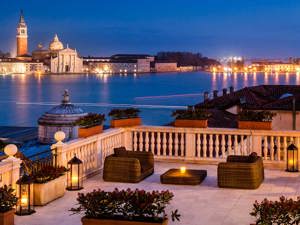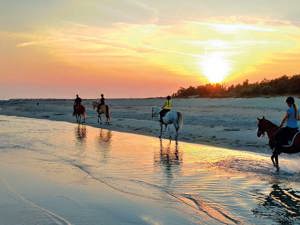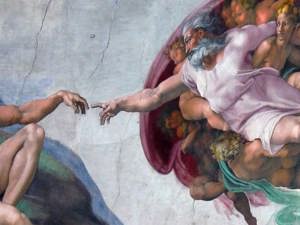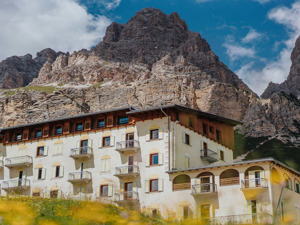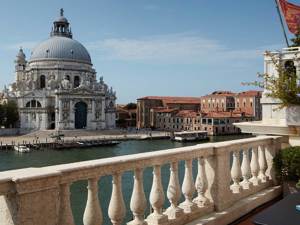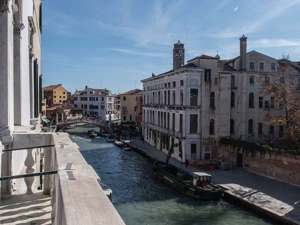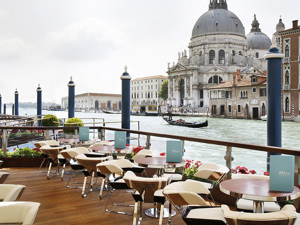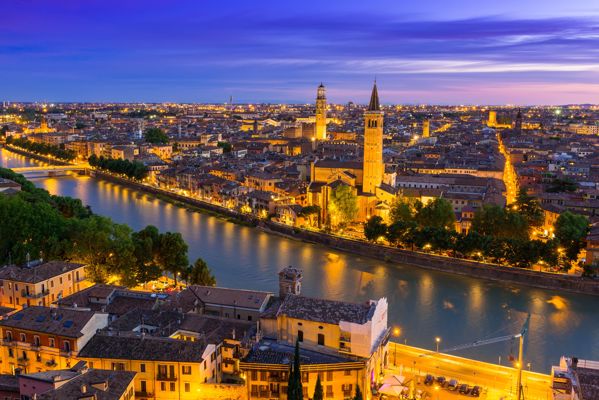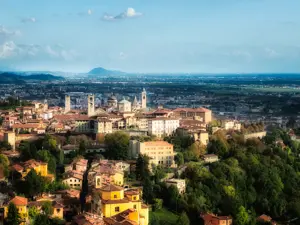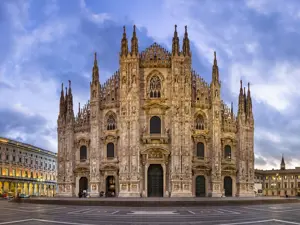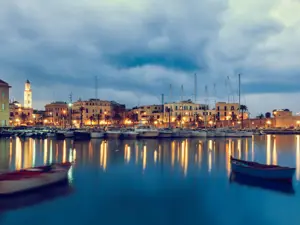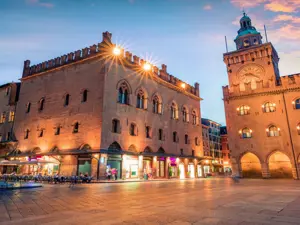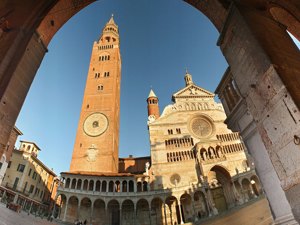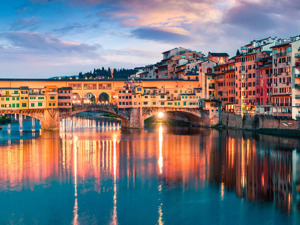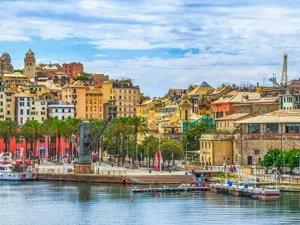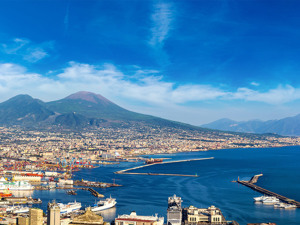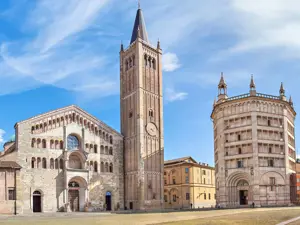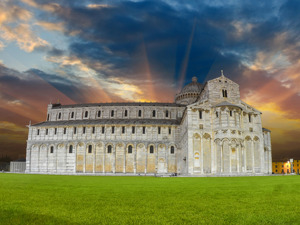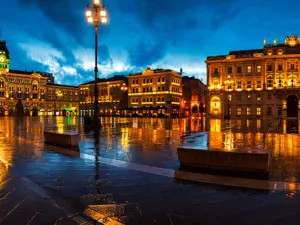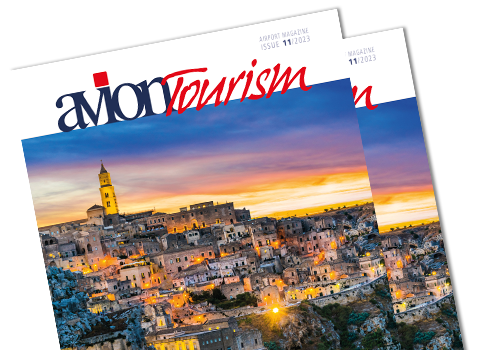The exclusive city of art created on the sea
As Thomas Mann stated, the most exciting way to get to Venice and enjoy all of its beauty is to arrive by sea. Only from the sea can you appreciate the city in its entirety, with its most spectacular buildings. The charm of the lagoon on which the city sits is made even more appealing by the gondolas, a romantic symbol of this timeless city, which have remained unchanged for centuries.
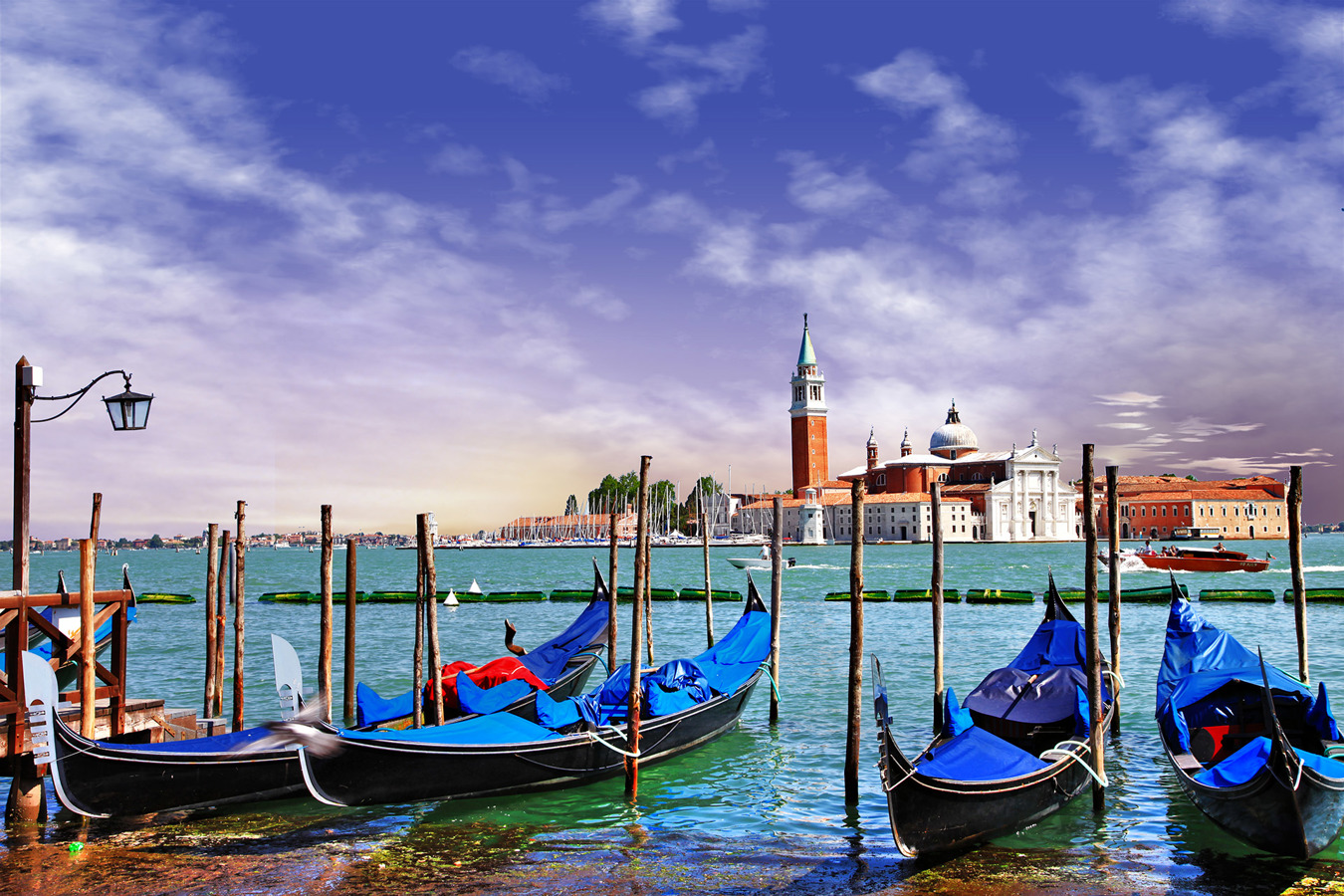
Venice. Photo: Copyright © Sisterscom.com / Shutterstock
The lagoon city is divided into six ancient districts known as ‘sestieri’, each filled with valuable art treasures and unique features.
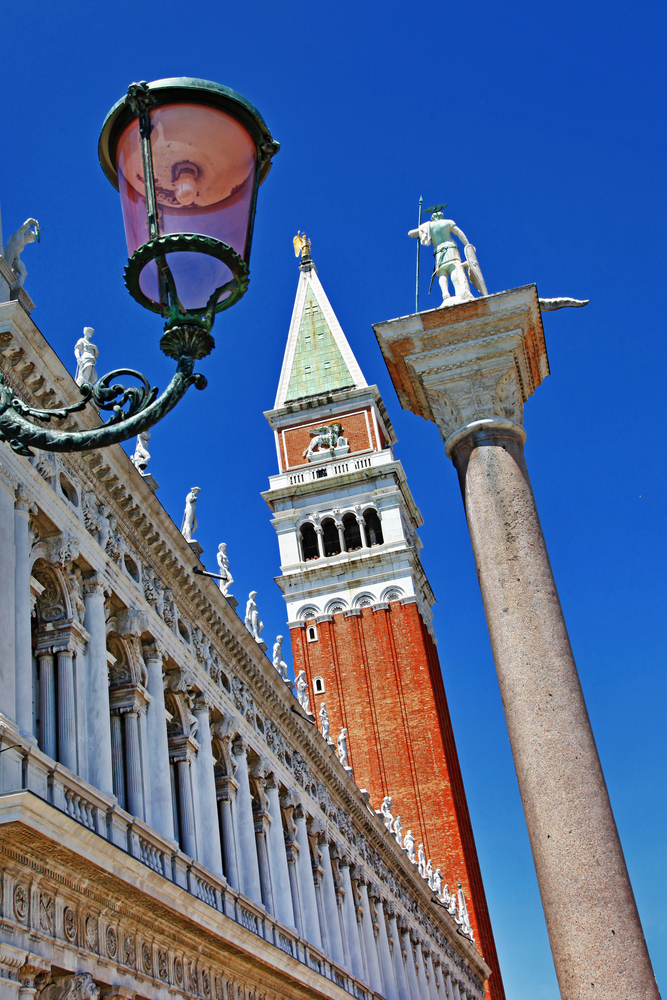
The bell tower of St. Mark’s Cathedral in Venice. Photo: Copyright © Sisterscom.com / Shutterstock
Piazza San Marco
‘Il più bel salotto d’Europa’
The sestiere of San Marco, or St. Mark, features the square of the same name, which was described by Napoleon I as being “the most beautiful meeting place in Europe”. It dominates the entire area and is surrounded by famous monuments:
- St. Mark’s Cathedral, built in Byzantine Venetian style in the tenth century to house the body of the evangelist Mark, who with his lion are a feature of the crest of the city;
- the Doge’s Palace, a triumph of Gothic architecture, once the seat of the Republic’s power and residence of the Doges;
- the Columns of San Marco and San Teodoro (St. Mark and St. Theodore), which once marked the main entrance of the city from the sea;
- the classic splendour of the National Library of St. Mark, the work of Palladio.
The square is also home to two old coffee bars, which were both founded in the eighteenth century and are housed in historical buildings. On one side of the square stands Caffè Florian, with its original nineteenth-century wood panelling, and on the other Caffè Quadri; both in the past were meeting places of the masters of the literary, artistic and music world.
The sestiere of San Polo has as its centre of interest the Rialto Bridge and its famous markets: this has always been the commercial heart of the city, where bankers and merchants conducted their business.
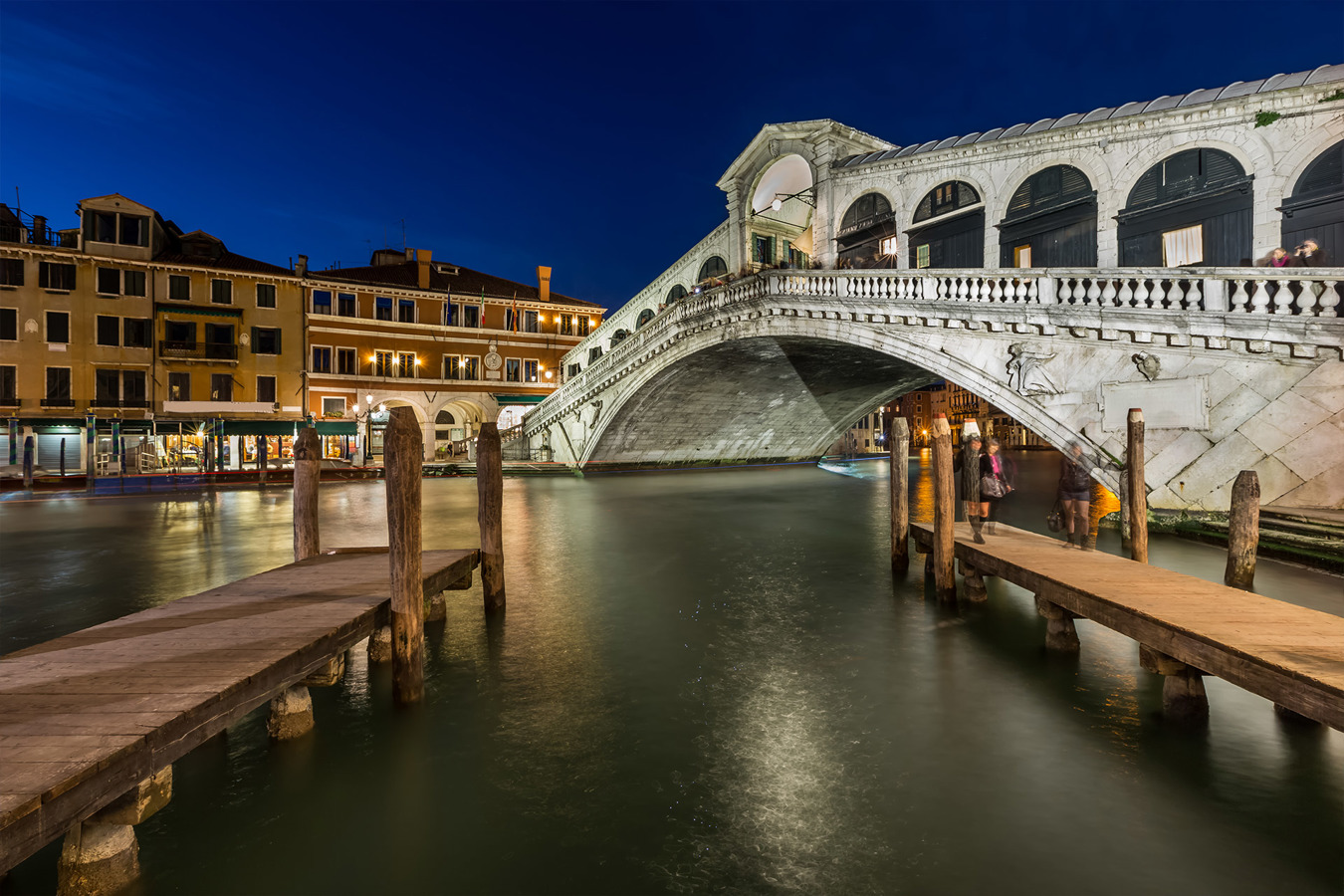
Venice. The Rialto Bridge. Photo: Copyright © Sisterscom.com / Shutterstock
The characteristic ‘bacari’ are found in this sestiere. These are traditional taverns that serve food consumed while standing. San Polo has one of the largest monuments in Venice, the very beautiful Church of Santa Maria Gloriosa dei Frari, (the friars minor - or Frari in dialect - founded this building), which has an exterior in Florid Gothic style and an Pure Gothic interior; one of the masterpieces it houses is the monumental Altarpiece depicting the ‘Assunta’ by Titian. Don’t miss in this small sestiere the Scuola Grande di San Rocco (Confraternity of St. Roch) - the scuole in Venice were once charitable institutions - the Venetian equivalent of the Sistine Chapel, which is admirably frescoed by a single artist, Tintoretto. Its construction, which began in the fifteenth century, was generously financed by the Venetians, who wished to dedicate it to St. Roch, protector against the plague, in the hope that he would protect them.
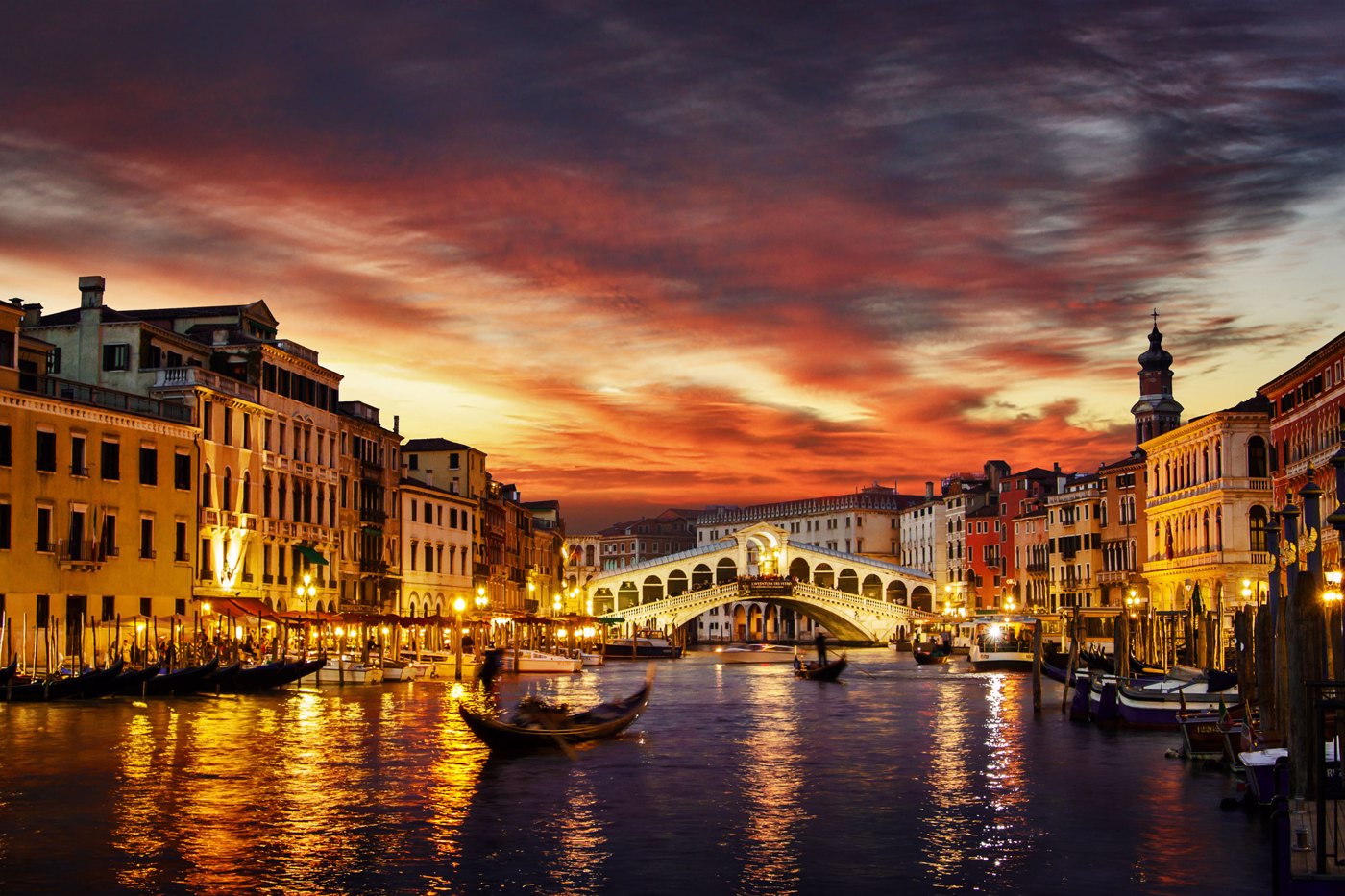
Venice. The Grand Canal. Photo: Copyright © Sisterscom.com / Shutterstock
The Castello sestiere is home to the Arsenale, built in the thirteenth century as an expression of the city’s maritime power, and once the largest shipyard in the world. Magnificent, important buildings line the Grand Canal, the world’s most famous waterway. These buildings, such as Ca’ Foscari, Ca’ d’oro, Ca’ Pesaro and Ca’ Rezzonico, were erected with no expense spared by the Venetians during the period of greatest splendour of the Republic, and a visit to these magnificent residences allows you to experience the opulence of the golden times of the ‘Serenissima’.
Anyone spending time Venice must visit the three most famous islands of the lagoon: Burano, famous for its traditional embroidery, Murano, known for its artistic glass, and Torcello, with its stupendous Byzantine cathedral. If you prefer a few days by the sea, there’s the Lido, kilometres of golden beach with excellent facilities.
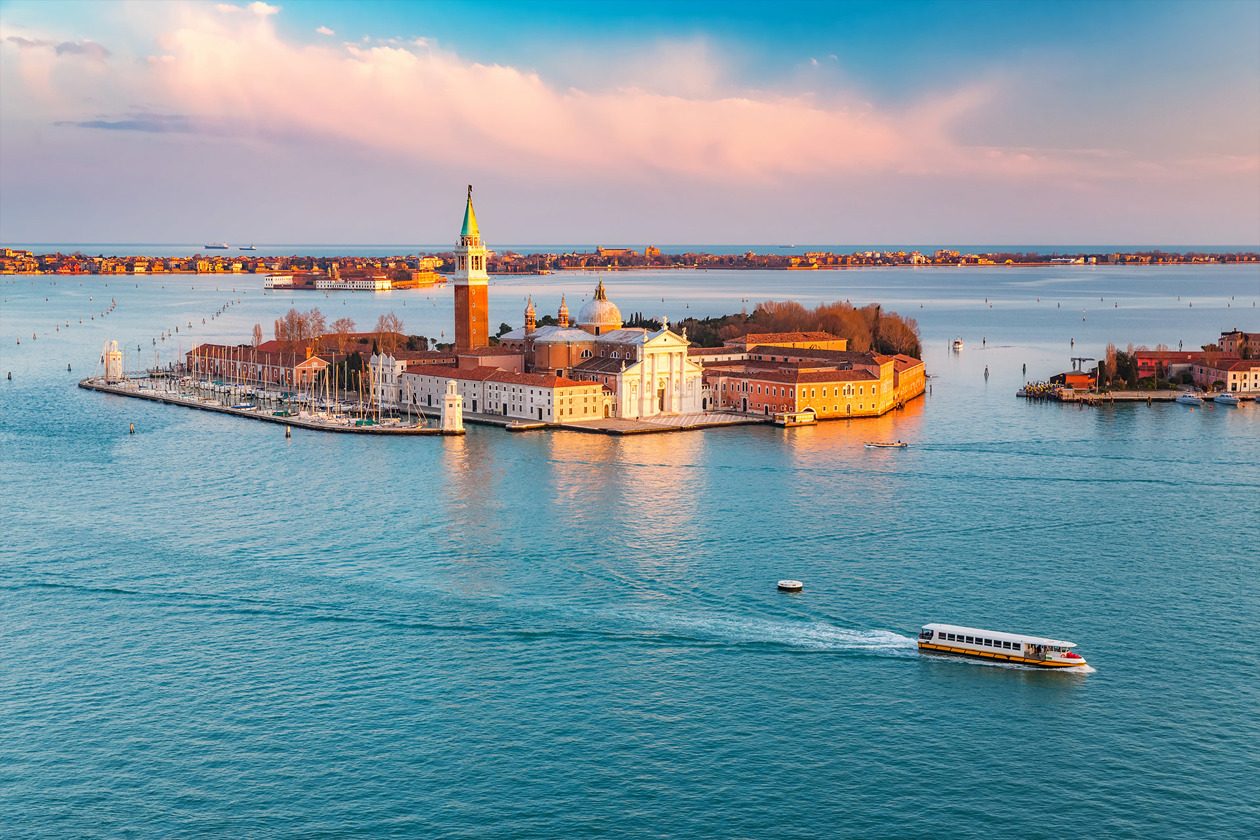
Venice. Photo: Copyright © Sisterscom.com / Shutterstock
The lagoon city, one of the places with the richest history and greatest number of monuments in the world, is alive with events like no other: these include the celebrated Biennale, an exhibition of contemporary and avant-garde art held from June to September, which also features an interesting film exhibition. But you should try to watch at least one of the traditional regattas, such as the one for the Festival of the Redeemer, held on the 3rd Sunday in July, or the Historical Regatta, on the first Sunday of September, and above all don’t miss the lively Carnival, which each year, on the Thursday before Lent and Shrove Tuesday, animates the streets with masks, songs, concerts, parades, processions and the local delicacy: the delicious ‘fritole’, fried doughnuts with raisins and pine nuts, cooked in the street.
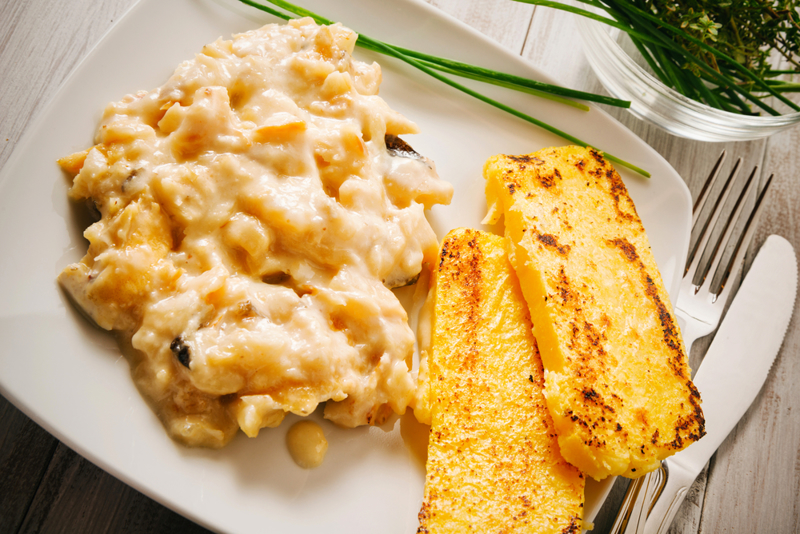
Baccalà alla vicentina. Photo: Copyright © Sisterscom.com / Shutterstock
Venetian cuisine
Pasta and beans, bigoli with duck, Vicenza-style cod, guinea fowl with pevarada sauce, radicchio with sopressa, fish broth, Venetian liver, are some of the dishes of the Venetian cuisine to try. Veneto is a wine region in the top places in Europe for the quality and quantity of wines produced, including the renowned prosecco.
Text by Anna Glik
Avion Tourism Magazine
Photos: Sisterscom.com; Shutterstock
Photos: Sisterscom.com; Shutterstock
Video: www.veneto.eu
Copyright © Sisterscom.com
Copyright © Sisterscom.com
Tourist Board
www.turismovenezia.it
www.comune.venezia.it
Where to sleep in Venice
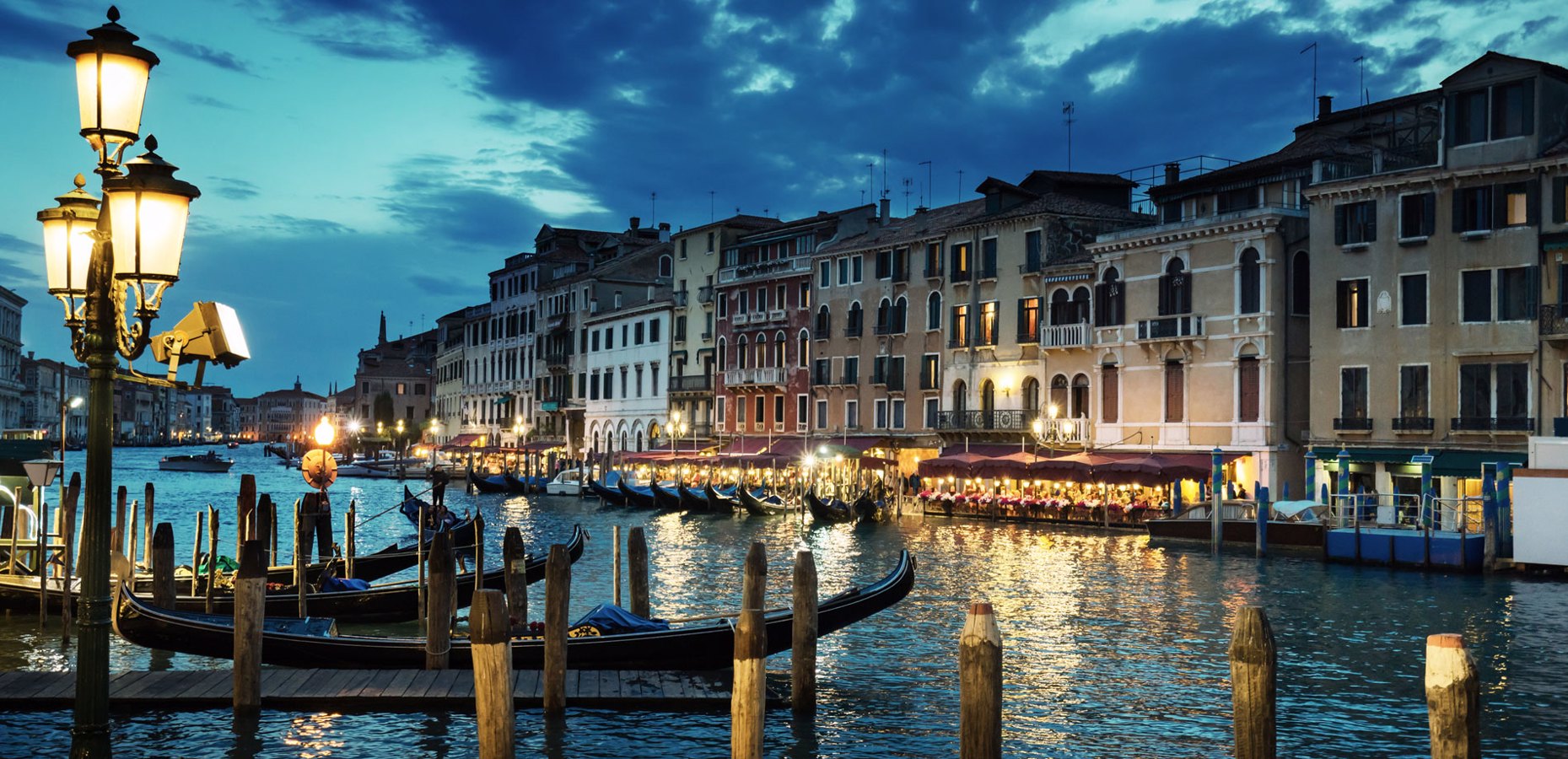
Venice. Photo: Copyright © Sisterscom.com / Shutterstock
Venice is a welcoming city and offers different possibilities for accommodation.
To find the ideal hotel and the best offers you can do a search for the stars but also for districts or landmarks.
DISTRICTS
Hotels in the districts
LANDMARKS
Hotel in tourist areas
WHERE TO GO in venice
Monuments
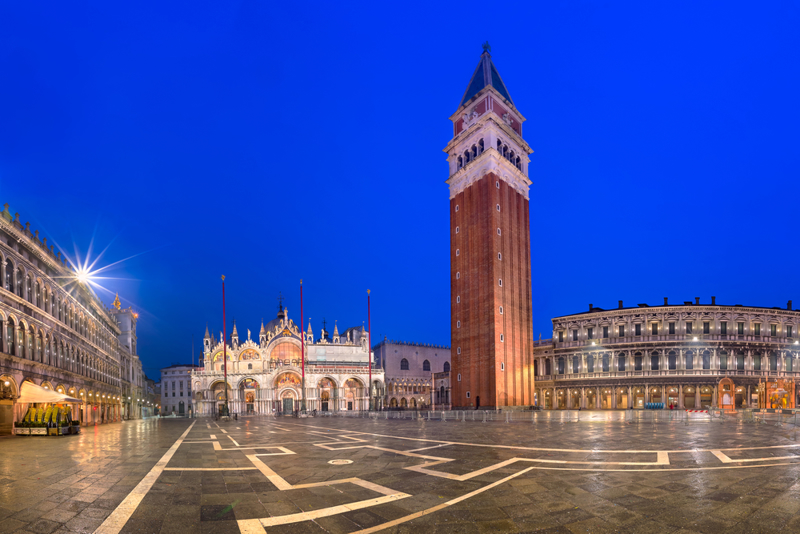
Copyright © Sisterscom.com / Shutterstock
SAINT MARK'S SQUARE
In the heart of Venice, Saint Mark's Squareis certainly the center of the city and has always been the heart of Venetian life with its famous coffee and atmosphere enlivened by the music. The Saint Mark's Basilica overlooks the square. The Basilica is a wonderful example of Byzantine Venetian style. It was at one time the Doge's chapel but it was also the mausoleum for Saint Mark, the patron saint, whose life is narrated in the golden mosaics on the walls.
Venice: skip the line golden Basilica Tour
Venice: skip the line golden Basilica Tour
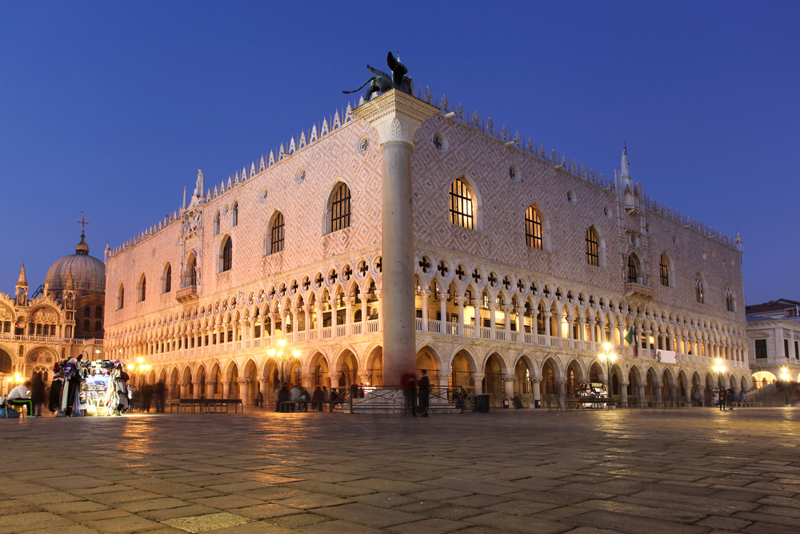
Copyright © Sisterscom.com / Shutterstock
DOGE'S PALACE
The Ducal Palace, the symbol of the city, was the political center of the Republic and is still the highest expression of Venetian art. In the past it was also the Doge's residence and headquarters of the main government departments. Walking through the its rooms, you will discover elements of painting and sculpture, which are the synthesis of the glorious history of the Republic of Venice.
Venice: Doge's Palace priority admission ticket
Venice: Doge's Palace priority admission ticket
Video: Copyright © Teatro La Fenice
FENICE OPERA HOUSE
The La Fenice Opera House was originally built in 1790 to a design by Selva and is located opposite the Church of San Fantin. Destroyed by fire in 1836, rose after little more than a year with the same configuration as the project of Meduna. Destroyed by a fire in 1996, the theater was reopened in December 2003.
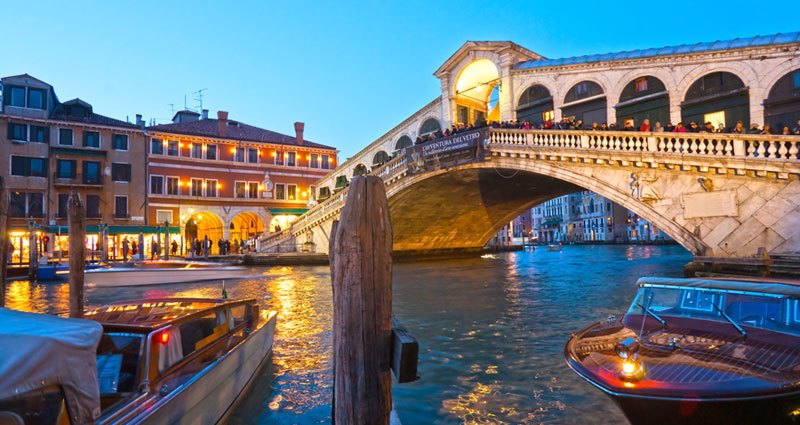
Copyright © Sisterscom.com / Shutterstock
RIALTO BRIDGE
The Rialto Bridge was completed in the sixteenth century, replacing the previous wooden bridge, and at one time was the only link between the two banks of the Grand Canal. On either side of the central passage of the bridge there are many shops, a symbol of craftsmanship in Venice.
Museums
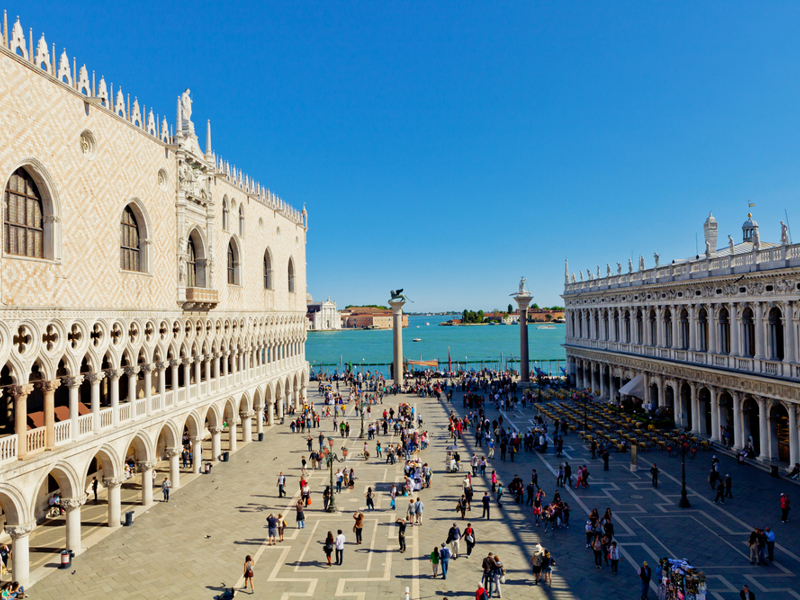
Copyright © Sisterscom.com / Shutterstock
NATIONAL ARCHAEOLOGICAL MUSEUM
The Archaeological Museum is part of the path of the Museums of St. Mark's Square and houses a collection of ancient Greek-Roman with Egyptian and Assyrian-Babylonian sections. Near to Ducal Palace are the famous collections by Domenico Grimani and his nephew John. It is a very valuable collection of original Greek marbles and a coin from the Church of Santa Maria Formosa.
Venice Museums Pass
Venice Museums Pass
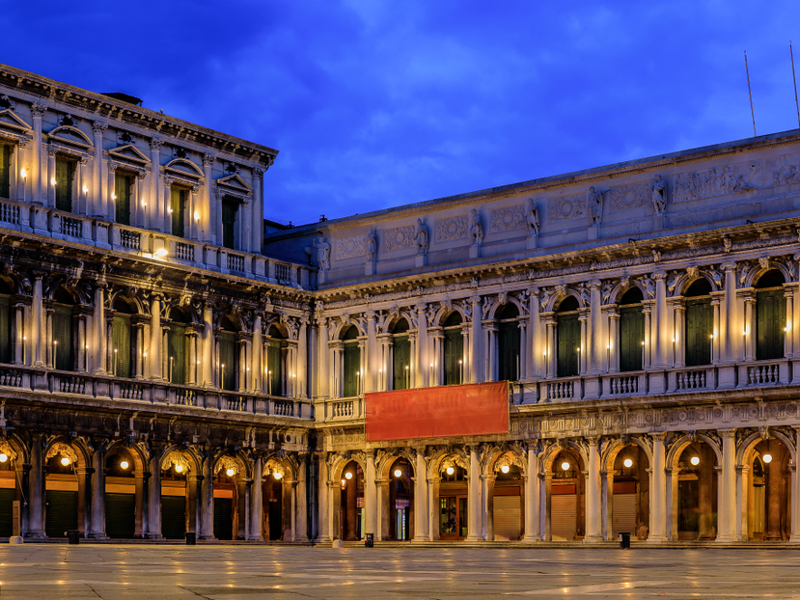
Copyright © Sisterscom.com / Shutterstock
CIVIC MUSEUM CORRER
The Civic Museum Correr is located in the spaces of the Napoleonic Wing in St. Mark's Square and in part of the Procuratie Nuove. The Museum was born from the collection which Teodoro Correr left to the city in 1830 and offers various itineraries: from the Neoclassical rooms, with sculptures by Antonio Canova, to the historical collections on institutions. Of particular interest is the Picture Gallery, which displays paintings by Venetian artists including G. V. Bellini and Carpaccio.
Venice Museums Pass
Venice Museums Pass
Excursions
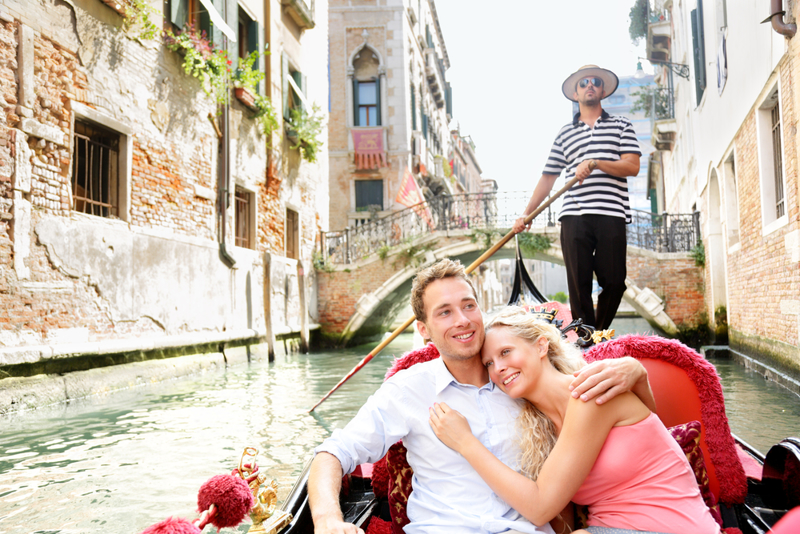
Copyright © Sisterscom.com / Shutterstock
GONDOLA ON THE GRAND CANAL
In Venice you can take a gondola ride through the Grand Canal and minor canals. The gondola is one of the major attractions of the city, from where you can get a different perspective of the city and allows you to discover the picturesque canals and views of incomparable beauty.
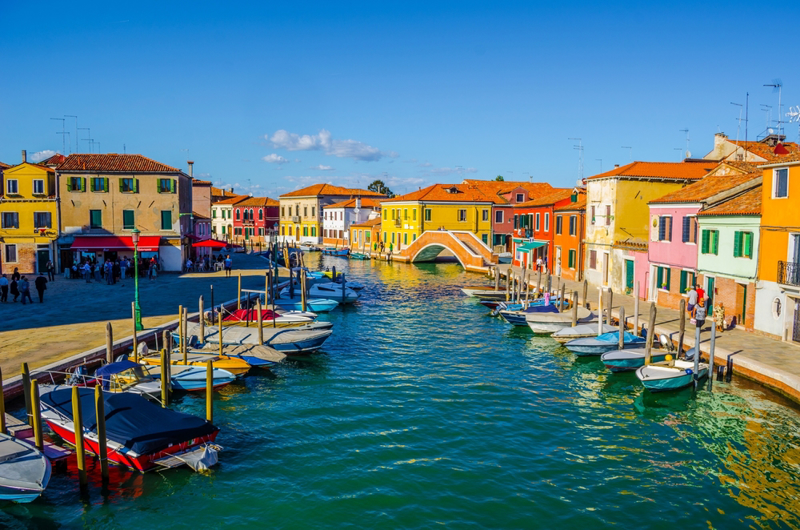 Copyright © Sisterscom.com / Shutterstock
Copyright © Sisterscom.com / ShutterstockMURANO ISLAND
The island of Murano is the island of blown glass, an ancient tradition still very much alive. Divided into nine islands is crossed by a large channel. The Glass Museum is today a must destination to learn about the art of glass production in Venice and has a rich collection of objects and decorative glass products from the fifteenth century to the present day.
Recommended tours
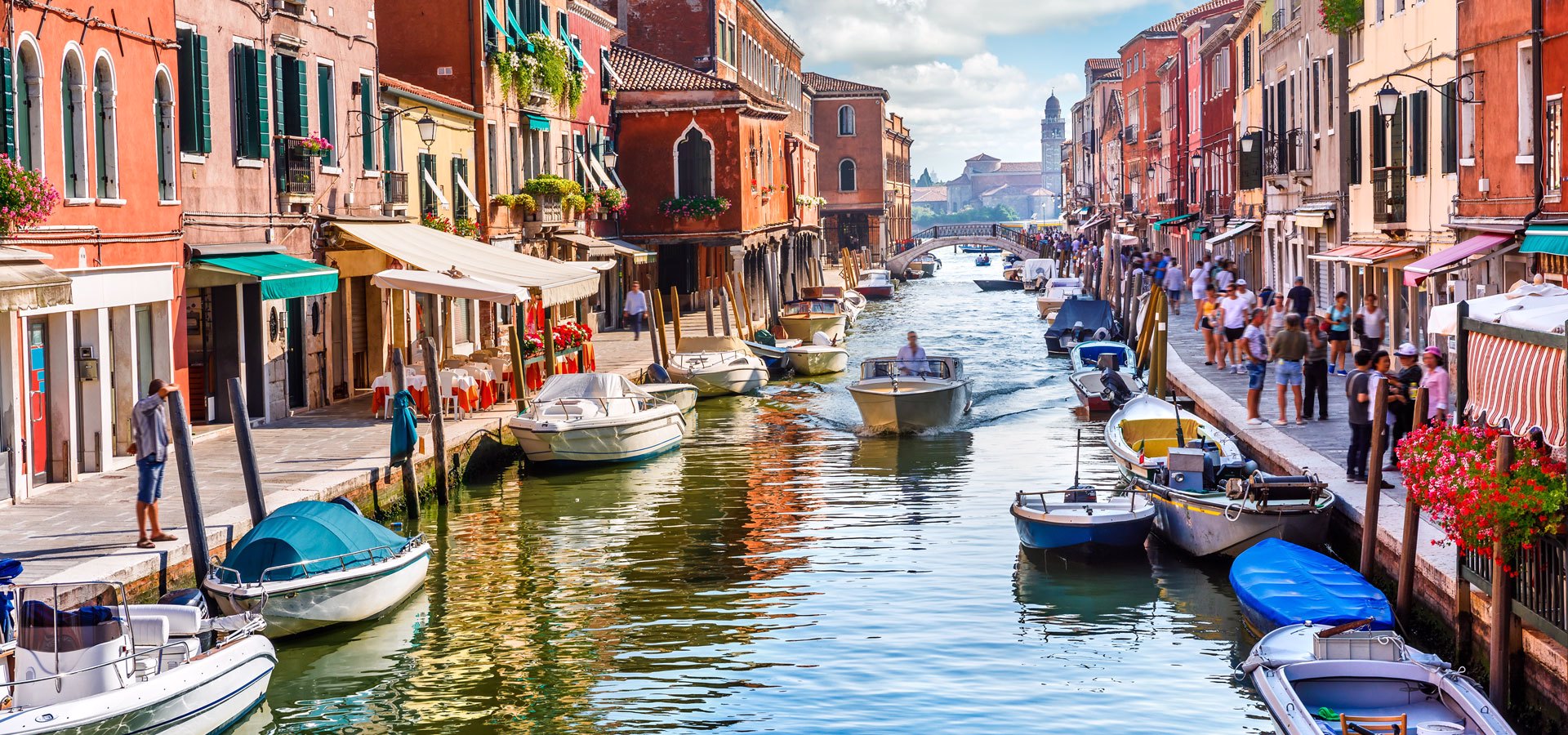
Murano - Photo: Copyright © Sisterscom.com / Shutterstock
MURANO, BURANO, TORCELLO
A boat tour to discover the famous Venetian islands of Murano, Burano and Torcello. Departure from Venice for Burano with its colorful houses, Murano with its blown glass and Torcello, another characteristic island. Boat trip: glimpse of Murano, Torcello and Burano Islands.
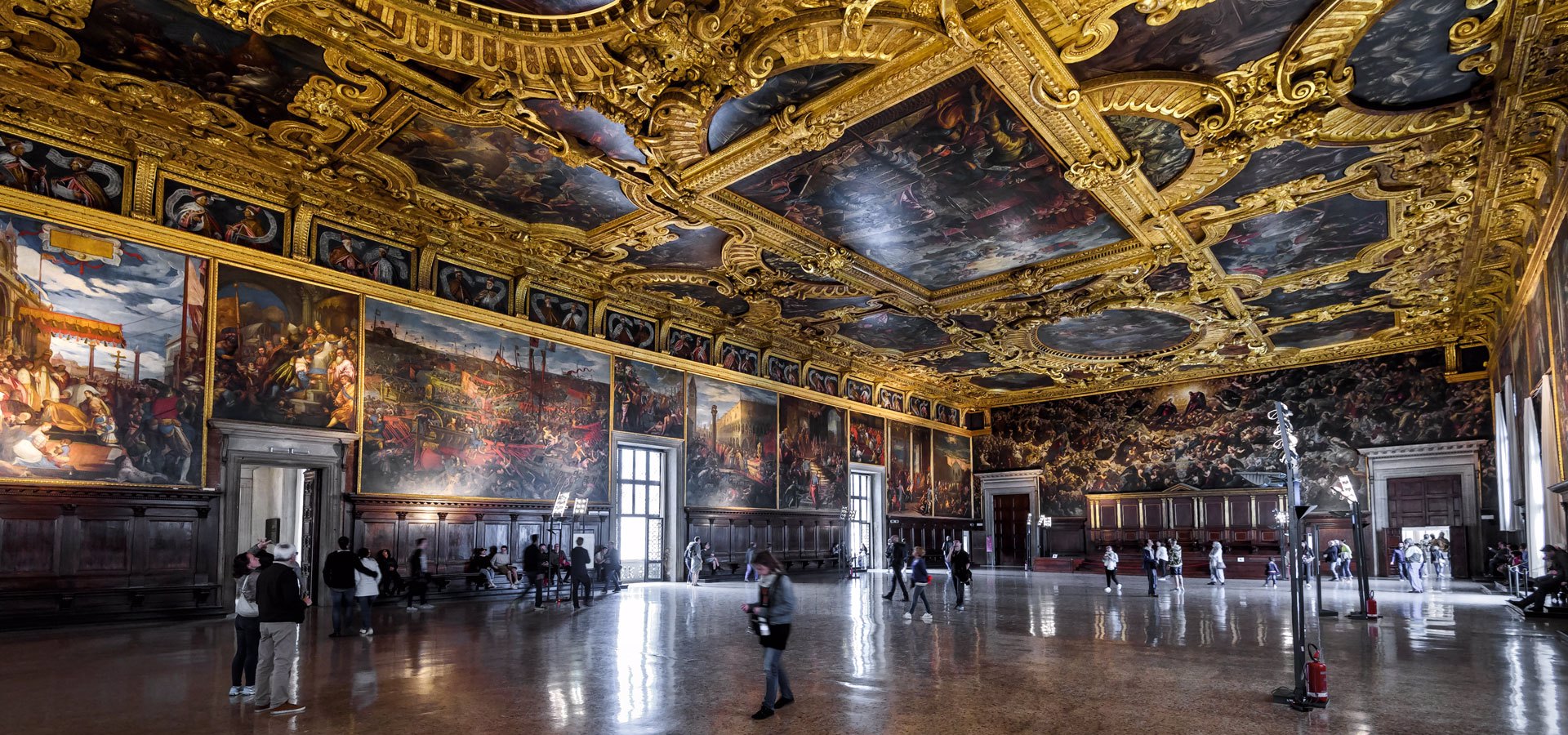 Doge's Palace - Photo: Copyright © Sisterscom.com / Viacheslav Lopatin / Shutterstock
Doge's Palace - Photo: Copyright © Sisterscom.com / Viacheslav Lopatin / ShutterstockDOGE'S PALACE
Entrance to the Civic Museums of San Marco: the Doge's Palace, the Correr Museum, the National Archaeological Museum and the Marciana Library. Also also the Ghetto Museum, in the former Jewish ghetto of Venice, the Glass Museum, the Lace Museum. Pass valid for 180 days. Venice Museum Pass & Doge's Palace entrance ticket.
PIAZZA SAN MARCO, ST MARK'S BASILICA, DOGE'S PALACE
Two hour walking tour to visit Piazza San Marco, the basilica of San Marco and the Doge's Palace with priority entrance, characterized by decorated rooms and pictorial masterpieces. Venice Doge's Palace and St Mark's Basilica skip the line tour.
Discover all tours
News & Useful info
Shopping
Luxury
You might be interested in
Destinations found in the vicinity
Other destinations
Airports nearby Venice

